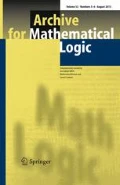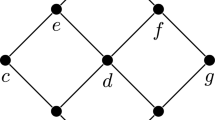Abstract
Using a countable support product of creature forcing posets, we show that consistently, for uncountably many different functions the associated Yorioka ideals’ uniformity numbers can be pairwise different. In addition we show that, in the same forcing extension, for two other types of simple cardinal characteristics parametrised by reals (localisation and anti-localisation cardinals), for uncountably many parameters the corresponding cardinals are pairwise different.




Similar content being viewed by others
Notes
The notation \(x\in ^\infty y\) naturally denotes \(\exists ^\infty \, i:x(i)\in y(i)\). We originally used \(\notin ^*\) instead of \(\notin ^\infty \), but this turned out to be unnecessarily confusing alongside our use of \(\in ^*\), since \(\notin ^\infty \) is not the negation of \(\in ^*\).
A brief note on notation: \(\mathfrak {c}^\forall _{c,h}\) and \(\mathfrak {c}^\exists _{c,h}\) were used in [10, 12, 14,15,16] with the meaning of covering \(\prod c\) with slaloms, where the relations for covering are \(\in ^*\) and \(\in ^\infty \), respectively. The notation \(\mathfrak {v}^\forall _{c,h}\) and \(\mathfrak {v}^\exists _{c,h}\) is intended to be read as avoiding or evading such coverings.
By similar methods, it can also be proved that \({\text {cof}}(\mathcal {M}) = \sup (\{ \mathfrak {d}\} \cup \{\mathfrak {c}^\exists _{c,h} \mid c \in \omega ^\omega \})\) and, whenever h goes to infinity, \({\text {add}}(\mathcal {N}) = \min (\{ \mathfrak {b}\} \cup \{\mathfrak {v}^\forall _{c,h} \mid c \in \omega ^\omega \})\) and \({\text {cof}}(\mathcal {N}) = \sup (\{ \mathfrak {d}\} \cup \{\mathfrak {c}^\forall _{c,h} \mid c \in \omega ^\omega \})\).
Note that the \(c'\) we work with here and in the subsequent proof is such that \(\prod c'\) already is a family of slaloms, which reduces the complexity of the Tukey connection (since we do not have to bijectively map sets to their cardinalities).
The usual creature forcing notation (as in e. g. [9]) defines the set of possibilities more abstractly as \({\text {poss}}(p, {\le }k) := \prod _{\ell \le k} p(\ell )\) and defines \(p \wedge \eta \) as a condition with an extended trunk (a concept which we did not deem necessary to introduce in our paper). Since working with possibilities \(\eta \) as sequences of singletons suffices for our proofs and is conceptually easier, we instead opted for this simpler definition.
Note that bigness is equivalent to the concept of completeness in the sense of [10].
For the first inequality, recall that \(\frac{x}{2}\le \lfloor x\rfloor \) iff \(x\ge 1\).
We can simplify property (S5) by restricting it to \(\ell =1\): Assume the statement holds for some \(\ell ' > 1\). Let \(f'_\alpha = f_\alpha \circ \mathrm {pow}_{\ell '}\). Then \(f_{b_\alpha ,g_\alpha } \le ^* f'_\alpha \) and \(f'_\alpha \ll g_{c_\alpha ,h_\alpha }\) still holds (by the definition of \(\ll \)). This is why we can work with \(f'_\alpha \) instead of \(f_\alpha \), in which case property (S5) is already satisfied for \(\ell =1\) and property (S6) remains true for \(f'_\alpha \).
Concretely, there are \(p_0 \in \mathbb {Q}\) and \(\nu < \kappa _\alpha \) such that \(p_0 \Vdash |\dot{F}| = \nu \). So we just replace \(\dot{F}\) by some \(\mathbb {Q}\)-name \(\dot{F}'\) for a subset of \(\prod c_\alpha \) of size \(\le \nu \) such that \(p_0\Vdash \dot{F}'=\dot{F}\).
References
Baumgartner, J.E..: Iterated forcing. In: Mathias A.R.D. (ed.) Surveys in Set Theory, London Math. Soc. Lecture Note Ser., Cambridge Univ. Press, Cambridge (1983), pp. 1–59. https://doi.org/10.1017/CBO9780511758867.002
Baumgartner, J.E.: Sacks forcing and the total failure of Martin’s axiom. Topol. Appl. 19(3), 211–225 (1985). https://doi.org/10.1016/0166-8641(85)90002-1
Brendle, J., Cardona, M.A., Mejía, D.A.: Filter-linkedness and its effect on preservation of cardinal characteristics. Ann. Pure Appl. Logic 172(1), 102856 (2021). https://doi.org/10.1016/j.apal.2020.102856, arXiv:1809.05004 [math.LO]
Bartoszyński, T., Judah, H.: Set Theory: On the Structure of the Real Line, A K Peters, Wellesley, MA, (1995). https://doi.org/10.1112/S0024609396222374
Blass, A..: Combinatorial cardinal characteristics of the continuum. In: Foreman, M., Kanamori, A. (eds.) Handbook of Set Theory. Springer, Dordrecht (2010), pp. 395–489. https://doi.org/10.1007/978-1-4020-5764-9_7
Brendle, J., Mejía, D.A.: Rothberger gaps in fragmented ideals. Fund. Math. 227(1), 35–68 (2014). https://doi.org/10.4064/fm227-1-4, arXiv: 1409.0222 [math.LO]
Brendle, J., Shelah, S.: Evasion and prediction II. J. Lond. Math. Soc 53(1), 19–27 (1996). https://doi.org/10.1112/jlms/53.1.19, arXiv: math/9407207 [math.LO]
Cardona, M.A., Mejía, D.A.: On cardinal characteristics of Yorioka ideals. Math. Log. Q. 65(2), 170–199 (2019). https://doi.org/10.1002/malq.201800034, arXiv: 1703.08634 [math.LO]
Fischer, A., Goldstern, M., Kellner, J., Shelah, S.: Creature forcing and five cardinal characteristics in Cichoń’s diagram, Arch. Math. Logic 56(7–8), 1045–1103 (2017). https://doi.org/10.1007/S00153-017-0553-8, arXiv: 1402.0367 [math.LO]
Goldstern, M., Shelah, S.: Many simple cardinal invariants. Arch. Math. Logic 32(3), 203–221 (1993). https://doi.org/10.1007/BF01375552arXiv: MATH/9205208 [math.LO]
Kechris, A.S.: Classical Descriptive Set Theory, Graduate Texts in Mathematics, vol. 156, Springer, New York (1995). https://doi.org/10.1007/978-1-4612-4190-4
Kellner, J.: Even more simple cardinal invariants. Arch. Math. Logic 47(5), 503–515 (2008). https://doi.org/10.1007/s00153-008-0094-2, arXiv: 0706.0319 [math.LO]
Kamo, S., Osuga, N.: The cardinal coefficients of the ideal \(\cal{I}_f\). Arch. Math. Logic 47(7–8), 653–671 (2008). https://doi.org/10.1007/s00153-008-0091-5
Kamo, S., Osuga, N.: Many different covering numbers of Yorioka’s ideals. Arch. Math. Logic 53(1), 43–56 (2014). https://doi.org/10.1007/s00153-013-0354-7
Kellner, J., Shelah, S.: Decisive creatures and large continuum. J. Symb. Log 74(1), 73–104 (2009). https://doi.org/10.2178/JSL/1231082303, arXiv: MATH/0601083 [math.LO]
Kellner, J., Shelah, S.: Creature forcing and large continuum: the joy of halving. Arch. Math. Logic 51(1–2), 49–70 (2012). https://doi.org/10.1007/S00153-011-0253-8, arXiv: 1003.3425 [math.LO]
Miller, A.W.: Some properties of measure and category. Trans. Am. Math. Soc. 266(1), 93–114 (1981). https://doi.org/10.2307/1998389
Rosłanowski, A., Shelah, S.: Norms on possibilities I: forcing with trees and creatures. Mem. Am. Math. Soc. 141(671), xii+167 (1999). https://doi.org/10.1090/MEMO/0671, arXiv: MATH/9807172 [math.LO]
Yorioka, T.: The cofinality of the strong measure zero ideal. J. Symb. Log. 67(4), 1373–1384 (2002). https://doi.org/10.2178/JSL/1190150290
Author information
Authors and Affiliations
Corresponding author
Additional information
Publisher's Note
Springer Nature remains neutral with regard to jurisdictional claims in published maps and institutional affiliations.
The first author was supported by the Austrian Science Fund (FWF) project P29575 “Forcing Methods: Creatures, Products and Iterations”. The second author was supported by the Austrian Science Fund (FWF) project I3081 “Filters, Ultrafilters and Connections with Forcing”, the grant no. IN201711 of Dirección Operativa de Investigación – Institución Universitaria Pascual Bravo, and by the Grant-in-Aid for Early Career Scientists 18K13448, Japan Society for the Promotion of Science. We are grateful to Martin Goldstern and Teruyuki Yorioka for giving helpful comments and suggestions to improve our paper.
Rights and permissions
About this article
Cite this article
Klausner, L.D., Mejía, D.A. Many different uniformity numbers of Yorioka ideals. Arch. Math. Logic 61, 653–683 (2022). https://doi.org/10.1007/s00153-021-00809-z
Received:
Accepted:
Published:
Issue Date:
DOI: https://doi.org/10.1007/s00153-021-00809-z
Keywords
- Yorioka ideals
- Cardinal characteristics of the continuum
- Localisation cardinals
- Anti-localisation cardinals
- Creature forcing



